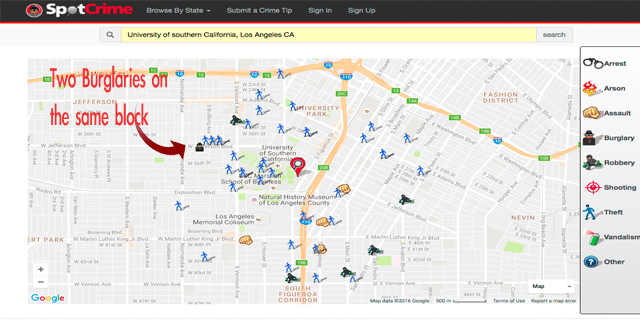A report published on October 27th by the Daily Trojan – the University of Southern California (USC) student newspaper – titled ‘Student’s death continues to impact safety, enrollment,” reports of Chinese students’ safety concerns ‘ in deciding whether or not to attend USC.
According to SpotCrime.com, five robberies, thirty-three thefts, and two burglaries had taken place from Oct. 21 through Oct 25, 2016, within USC’s surrounding area. Naive international students can easily put themselves in danger just by renting property on the wrong block. This is precisely what happened to graduate students Ming Qu and Ming Yu. In 2012, they were both fatally gunned down in a robbery attempt while parked outside a house just one mile from campus.
This tragedy gave rise to protracted discussions on several Chinese media outlets about students’ safety in the United States. Shortly thereafter, USC had promised to increase security both on and off campus. But just two years later, another Chinese student, Ji, an only child, was murdered in yet another robbery attempt.
Although the killer recently was sentenced to life in prison, this act of American justice did nothing to alleviate the fears of prospective Chinese students and their parents. USC’s administration now appears to be aware of the psychological impact these murders have had on prospective Chinese students, which in turn has affected the school’s reputation and revenue stream. The school newspaper states:
Ji’s death continues to affect the international student community at USC, particularly among Chinese students who think the University needs to increase safety measures.
So, has USC done anything to reduce the possibility of similar tragedies from occurring again? Yes. And although they have enacted various safety measures, many international students believe more can be done to help ensure their safety.
Two weeks after Ji’s death, the University announced that it would add extra neighborhood security ambassadors, upgrade security technology, and decrease Campus Cruiser’s wait times in an effort to increase safety on and around campus.
Even so, this begs the question: doesn’t USC have a moral obligation to inform international students of the community’s dangers long before classes begin, and to emphasize this issue during orientation? Gao, president of the Chinese Student and Scholars Association suggests:
The school already spends a lot of money and resources to ensure a secure environment. However, the main issue is the education process. Before we enter the school, we should be informed of any safety [hazards] in the surrounding areas during our orientation.
But for all it’s good intentions, USC’s stopgap safety measures will remain about as effective as treating cancer with a band-aid. Ultimately, urban renewal and practical solutions to combating drug violence and poverty are what will make USC’s community a safe and desirable place to live in.
With its sizeable 4.0 billion-US-dollar annual endowment, perhaps USC should consider investing in the surrounding area and begin transforming itself into one of the safest colleges in the United States.


Trackbacks/Pingbacks